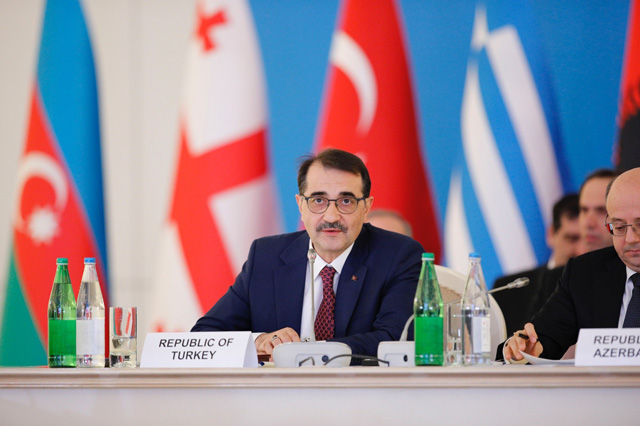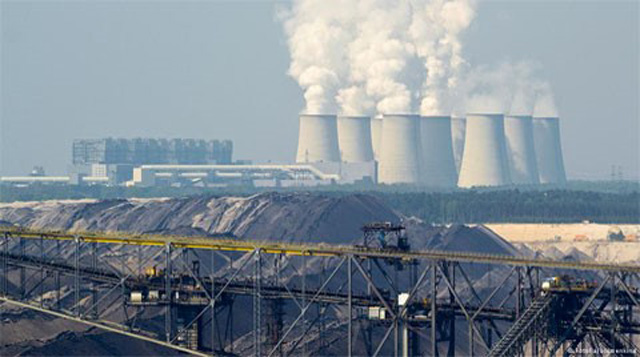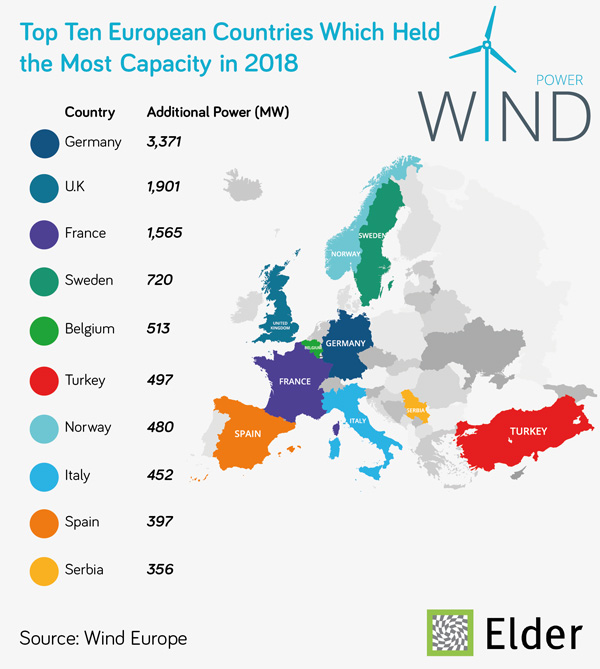
The Trans Anatolian Natural Gas Pipeline Project (TANAP) will strengthen Turkey's position as a key energy country, according to Turkey's Energy and Natural Resources Minister Fatih Donmez on Wednesday.
During the 5th Ministerial Meeting of the Southern Gas Corridor (SGC) Advisory Council in Azerbaijan's capital Baku, Donmez said the pipeline, which already transfers gas to Turkey, would see its extension to the Greek border in the coming months when the project's infrastructure construction is completed.
"On June 12 last year, we witnessed the timely completion of TANAP. The first gas deliveries to Turkey occurred on June 30, 2018. Over the next few months, infrastructure works for the Greek border will be finished," he said.
The TANAP pipeline forms the backbone of the Southern Gas Corridor - a project that aims to increase and diversify European energy supply by bringing gas resources from the Caspian Sea, namely the Shah Deniz 2 gas from Azerbaijan, to markets in Europe.
"The Southern Gas Corridor is one of the most important projects demonstrating the commitment of the countries in the region," Donmez said, adding that it creates a large value chain from producer to final consumer with an investment requirement of more than $45 billion.
Donmez commended TANAP as a historical project in which Turkey's energy position in the region would be strengthened, and in which Europe would obtain more diversified supply sources.
"Azerbaijan will provide access to new markets with its supplier country position. Europe will increase the source country and route diversity," he said.
- TANAP at a glance
The 1,850 kilometers-long TANAP and the 878 kilometers-long Trans Adriatic Pipeline project (TAP) were interlinked at the Maritsa River located on the Turkey-Greece border, a statement from the TANAP company said Wednesday.
The 16 billion cubic meter capacity pipeline will deliver 6 billion cubic meters of gas to Turkey per year while the remaining 10 billion cubic meters is destined for European markets via the TAP.
The TAP will transverse Greece, Albania, and the Adriatic Sea to reach Italy.
Commenting on the speed of the TANAP's construction, Donmez said he hoped the TAP project would be completed just as quickly as the TANAP.
The pipeline is expected to be ready to deliver its first gas to the European markets by mid-2020.
Source: AA

Banks in Turkey plan to restructure between $7 and $8 billion of current credit debt of energy companies so they can repay their debts by 2020-2021 and ease their ability to potentially participate in further energy investments during this term, Ebru Dildar Edin, executive vice president for corporate and investment banking at Garanti Bank, said Thursday.
Established in 1946, Garanti Bank is Turkey’s second largest private bank with consolidated assets of more than 398 billion Turkish liras ($75.7 billion) as of Dec. 31, 2018. Garanti has Banco Bilbao Vizcaya Argentaria S.A. (BBVA) as its majority shareholder with a 49.85 percent share interest.
In an exclusive interview with Anadolu Agency, Edin reflected on the last two years which were challenging for the Turkish energy sector, with the dramatic decrease in the Turkish lira especially from August 2018, the decline in oil prices, the increased cost of electricity generation at a time when there were constraints of lowering electricity prices in the market because of surplus supplies.
"We foresee that electricity prices will rise to $0.60 per kilowatt-hour during this term when companies will again start earning money. This circle will open the way for new big investments in the Turkish energy sector because all investors need to see that the existing companies begin earning money," she said.
When the banks formulated loans for energy companies, they foresaw electricity prices based on $0.70 per kilowatt-hour, however in reality, market prices fell to as low as $0.45 per kilowatt-hour, she explained.
"This difference between our calculations and the real prices led energy companies to have difficulties in their repayments," she said, adding that investments of around $85 billion were made for the power generation sector from which $25 billion came from the capital of these companies.
"However, the remaining $60 billion investment was carried out with financing from the banks. The companies have paid $20 billion of the total, while $40 billion is yet to be paid. A total amount of $13 billion, including the debts of electricity distribution companies, is required to be restructured. Banks restructured $4 billion in 2017 and 2018," she explained.
For 2019, banks will restructure a further $7 to $8 billion more credit, which has already been agreed with some energy companies. This, she explained, will enable all the companies to make repayments after the restructure is completed through 2020-2021.
Restructured finance includes local coal, natural gas and some hydroelectricity power plants, which are very important for the sustainability of the Turkish electricity generation sector, she said.
- Banks could help support gas plants
Edin stated that some natural gas power plants should be excluded at this point because they work at very low capacities so they cannot sell enough electricity to market to be able to meet their repayments.
In order for these companies to weather the storm of financial difficulties, she proposed a new business model in which these plants, which are crucial in meeting the country's peak demand, could obtain newly-created funds from some banks until a certain level of profitability and sustainability is reached.
She emphasized that with the country's increased electricity consumption, which increased year on year by 0.8 percent in 2018, Turkey would need all these power plants in the coming five to seven years.
"Turkey does not have a problem in terms of supply security but as there is currently no big investment, we could face a threat in 2022-2023. As there will be a need for new capacities, we should sustain our existing plants to meet any potential demand," Edin suggested.
She detailed that Garanti Bank has been financing only renewable energy projects over the last years and will continue to do so provided the project has a guarantee of purchase or support from any scheme like the Renewable Energy Sources Support Scheme (YEKDEM).
Edin concluded that YEKDEM should continue after 2020 even if it supports the projects at lower monetary levels.
The YEKDEM project, which started in 2011, has supported solar energy plants at $0.133 per kilowatt-hour, and wind and hydroelectricity plants at $0.73 per kilowatt-hour.
Turkey plans to end this renewable incentive scheme by 2020, however, it is unclear if the Turkish government will continue to support renewable projects with an alternative scheme.
Garanti Bank's funding for the power generation sector stands at $9 billion, from which 60 percent includes 145 renewable energy projects amounting to over 7,000 megawatts in capacity.
Source: AA

The European Union installed around 8.0 GW of solar power systems in 2018; that is a 36% year-on-year increase over the 5.9 GW connected to the grid in EU-28 in 2017, according to an estimate from SolarPower Europe, the association for the solar power sector in Europe.
Solar installations in Europe as a whole grew by around 20% to 11.0 GW in 2018, up from 9.2 GW the year before.
Walburga Hemetsberger, CEO of SolarPower Europe said: “It is good to see Europe fully embracing solar again. With solar being the most popular energy source among EU citizens, the most versatile and often also the lowest cost power generation source, and with cost reductions continuing, we are only at the beginning of a long upward trend for solar in Europe.”
Aurélie Beauvais, Policy Director of SolarPower Europe commented: “We will see very strong demand for solar in Europe in the next two years. One of the main reasons is the upcoming EU 2020 targets, where many member states will opt for low-cost solar to meet their obligations. Beauvais added: “The EU has done its homework – by removing the trade measures on solar panels and ensuring a highly positive framework for solar through the Clean Energy Package legislation, the stage is set for significant solar growth. Now it is important that EU member states enforce the right national climate and energy plans to sustain this solar boom.”
Europe’s largest solar market in 2018 was Germany with 2.96 GW of new grid-connected capacity, up 68% from the 1.76 GW installed in 2017.
It was followed by Turkey, the reigning European solar market from the previous year, which installed 1.64 GW in 2018, down 37% from the year before, after a decline in demand due to the financial downturn in the country. A rising solar star, the Netherlands ranked as the 3rd largest solar market in 2018.
The country added around 1.4 GW compared to 0.77 GW in 2017 and is now entering the ‘solar gigawatt-club’ for the first time.
Michael Schmela, Executive Advisor and Head of Market Intelligence at SolarPower Europe said: “While the EU-28’s 36% solar market growth in 2018 is very impressive, the number could have been even higher. But a sudden demand pull from China at the end of last year led to a supply shortage for high-quality panels in Europe, forcing several developers to delay the completion of projects into 2019. However, the good news is that 2019 will be an even better year for solar in Europe.”
This solar installation data for EU-28 and Europe is an estimate from SolarPower Europe for 2018 solar power on-grid installations and are based on official data from government agencies whenever possible. If such information was not available from primary sources, SolarPower Europe has gathered data mostly through its members, comprising of national solar associations.
As data for Q4/2018 is often not yet completely available or will be updated by national entities responsible for solar statistics in the coming months, the final installation numbers might differ from this estimate. Data for EU-28 includes all European Union member states. Data for Europe includes Belarus, Norway, Russia, Serbia, Switzerland, Turkey, Ukraine and others.
Source: SolarPower Europe

EU innovative climate action, as announced today, has a range of benefits for the health and prosperity of Europeans with an immediate, tangible impact on people's lives – from the creation of local green jobs and growth, to energy-efficient homes with a reduced energy bill, cleaner air, more efficient public transport systems in cities, and secure supplies of energy and other resources.
Commissioner for Climate Action and Energy Miguel Arias Canete said: “Less than three months after adopting our strategic vision for a climate neutral Europe by 2050, we are putting the money where the mouth is. Our objective is to keep building a modern, competitive and socially fair Paris-aligned economy for all Europeans. For this to happen, we will need deployment of clean innovative technologies on an industrial scale. This is why we are investing in bringing to the market highly innovative technologies in energy intensive industries, in carbon capture, storage and use, in the renewable energy sector and in energy storage. We are today unleashing technological solutions in all Member States and pressing the fast-forward button in our transition to a modern and climate-neutral society in Europe.”
The Commission wants to ensure that Europe continues to be at the top of the league as regards new high-value patents for clean energy technologies. This leadership provides a global competitive advantage, allowing Europe to harvest first mover benefits by increasing exports of European sustainable products and sustainable technology and business models.
On 28 November 2018, the European Commission adopted a strategic long-term vision for a prosperous, modern, competitive and climate neutral economy by 2050 – A Clean Planet for all.
The strategy shows how Europe can lead the way to climate neutrality while preserving the competitiveness of its industries by investing into realistic technological solutions. This transition also requires further scaling-up of technological innovations in energy, buildings, transport, industry and agriculture sectors.
The Commission aims to launch the first call for proposals under the Innovation Fund already in 2020, followed by regular calls until 2030.
Source: European Commission

Germany will rely heavily on neighboring nations in Europe to avert blackouts as it weans itself off coal over the next two decades, a senior government official said.
Europe’s biggest consumer of electricity is working to shut power plants fueled by both coal and nuclear energy that account for half of the nation’s generation capacity. Thomas Bareiss, a deputy economy and energy minister, acknowledged that retiring all those plants poses a challenge that may leave Germany reliant on imported electricity.
“It means thinking ahead and acting in concert in an already active cross-border market,” Bareiss said in an interview in Essen.
The remarks indicate the scale of the challenge Chancellor Angela Merkel’s government has embraced in vowing to close all its 120-some coal plants by 2038, including “front-loading” many of the closures early in the next decade. Alarmed by the meltdown of the Fukushima power station in Japan in 2011, Germany also is working to eliminate nuclear energy by 2022.
Bareiss said Germany is planning discussions in Berlin with representatives from EU nations about how it can secure power capacity during the phaseout. For years, Germany has been working to replace those traditional forms of power generation that work round the clock with wind, solar and natural gas plants, whose output is more variable.
The move to shut hard coal and lignite plants, which together provided about 38 percent of all power in Germany last year, needs “close coordination all the way with neighbors,” said Bareiss, a member of Merkel’s Christian Democrat party.
Source: Bloomberg

Spain’s Socialist government announced a 47 billion euro ($53 billion) public investment plan on Wednesday to tackle climate change over 10 years, which would be partly financed by issuing green bonds.
The proposal, which sets a goal to make Spain carbon neutral by 2050, is a statement of intent as the government faces a general election on April 28.
Prime Minister Pedro Sanchez said the plan would also be partly financed by EU funds but did not give details.
The draft package includes a plan to offset job losses in polluting industries.
“We aren’t proposing anything fanciful,” Sanchez told a news conference at the energy and environment ministry, which he merged when he took power in June.
“It’s necessary and moreover it’s possible,” he added.
As well as a draft law, the package includes a delayed national plan to combat climate change, which is due to be approved at a cabinet meeting on Feb. 22 and sent to the European Union for its sign-off.
While there is probably time for the plan to be sent to Brussels, April’s snap election makes it unlikely the draft bill will be approved under the current government.
The government will set out a calendar of capacity auctions to work toward a target of producing 74 percent of Spain’s electricity from renewable sources by 2030 and 100 percent by 2050, it said in a statement.
European Union climate chief Miguel Arias Canete has called on Europe to cut net greenhouse gas emissions to zero by 2050.
Overall, Spain’s plan will generate investment worth 200 billion euros, the government said, and should cut its reliance on imported energy to 59 percent from 74 percent over the decade.
This would help the state save 75.4 billion euros in fossil fuel costs over the next 10 years, it said.
Source: Reuters
Innovation Landscape For A Renewable-Powered Future
The integration of solar and wind power poses specific challenges as system operators pursue low-carbon investments and long-term energy sustainability. As these variable renewable energy (VRE) sources reach high shares of power generation, power systems must be increasingly flexible to maintain the balance of supply and demand over each day or year.
In response, policy makers and system operators around the world seek new enabling technologies, business models, market designs and system operation measures, aiming to make optimal use of VRE in this evolving landscape. Innovation initiatives, therefore, look for solutions that boost system flexibility.
The International Renewable Energy Agency (IRENA) has analysed the innovation landscape for VRE integration, mapping and categorising innovative solutions and on-the-ground examples.
The resulting report aims to provide a guide to current innovations, either under development or already in use, in different settings across the globe.Please click here to read the full report.

